How OPC Server and SISORT®DA system control 29 substations without SCADA
by Philippe Maurin, Gustavo Ferraz, Eduardo Freitas, RD&I, ORTENG Equipamentos e Sistemas.
ORTENG is supplying the electrical and automation systems of 29 substations with 1,431 IEDs for oil refinery Abreu e Lima of Petrobras, which is being built at Ipojuca, Brazil. Each substation has at least one SISORT DA system working in a redundant configuration with a total of 44 systems and a total of 80,000 OPC items. Each system has an OPC Server (SISORT-OPC Server) connected to at least two (and up to six) OPC Clients, including DCS OPC Clients and Event Recorder OPC Clients.








